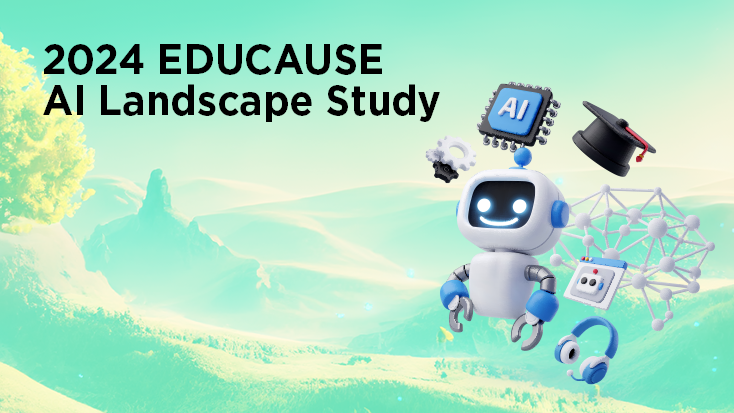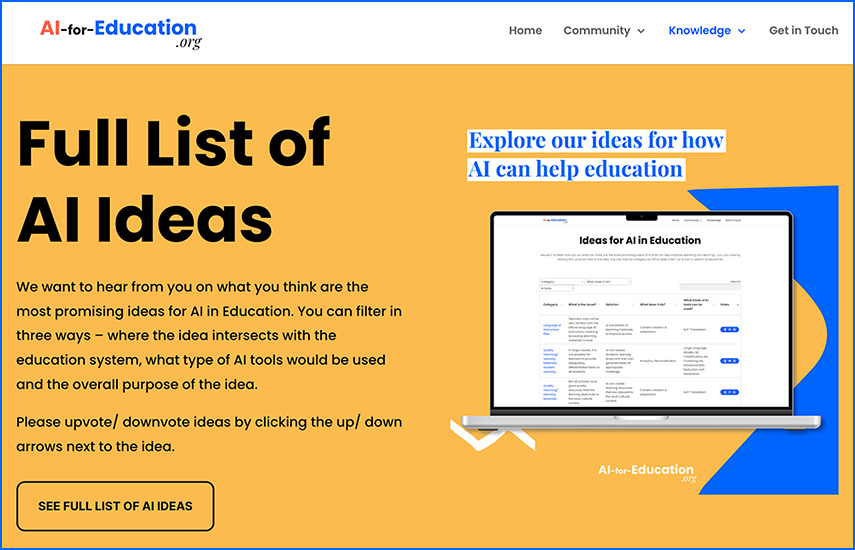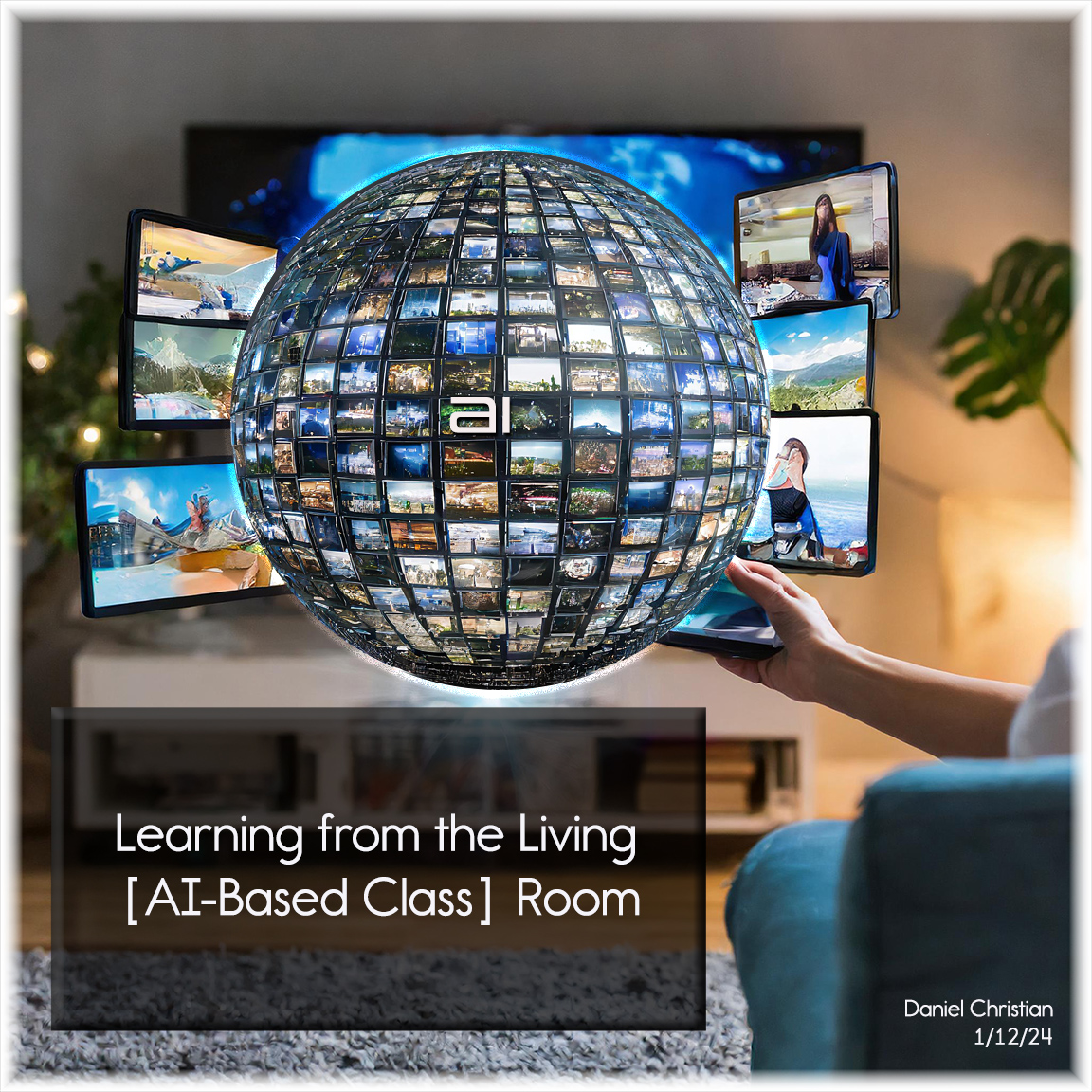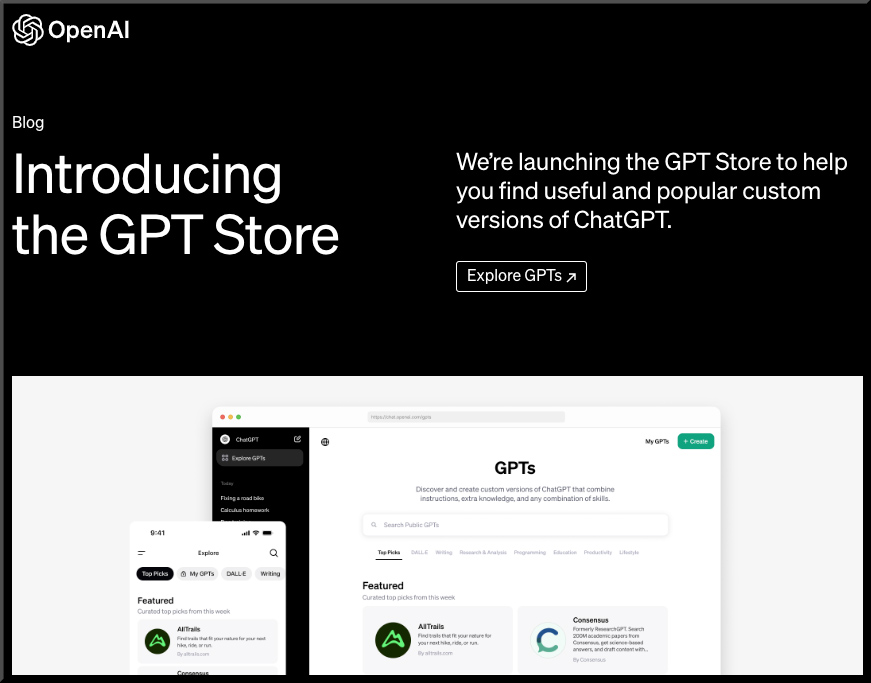From DSC:
I recently ran into the following item:
UK university opens VR classroom — from inavateonthenet.net
Students at the University of Nottingham will be learning through a dedicated VR classroom, enabling remote viewing and teaching for students and lecturers.
Based in the university’s Engineering Science and Learning Centre (ELSC), this classroom, believed to be the first in the UK to use a dedicated VR classroom, using 40 VR headsets, 35 of which are tethered overhead to individual PCs, with five available as traditional, desk-based systems with display screens.
I admit that I was excited to see this article and I congratulate the University of Nottingham on their vision here. I hope that they can introduce more use cases and applications to provide evidence of VR’s headway.
As I look at virtual reality…
- On the plus side, I’ve spoken with people who love to use their VR-based headsets for fun workouts/exercises. I’ve witnessed the sweat, so I know that’s true. And I believe there is value in having the ability to walk through museums that one can’t afford to get to. And I’m sure that the gamers have found some incredibly entertaining competitions out there. The experience of being immersed can be highly engaging. So there are some niche use cases for sure.
- But on the negative side, the technologies surrounding VR haven’t progressed as much as I thought they would have by now. For example, I’m disappointed Apple’s taken so long to put a product out there, and I don’t want to invest $3500 in their new product. From the reviews and items on social media that I’ve seen, the reception is lukewarm. At the most basic level, I’m not sure people want to wear a headset for more than a few minutes.
So overall, I’d like to see more use cases and less nausea.
Addendum on 2/27/24:
Leyard ‘wall of wonder’ wows visitors at Molecular Biology Lab — from inavateonthenet.net
Scammers trick company employee using video call filled with deepfakes of execs, steal $25 million — from techspot.com by Rob Thubron; via AI Valley
The victim was the only real person on the video conference call
The scammers used digitally recreated versions of an international company’s Chief Financial Officer and other employees to order $25 million in money transfers during a video conference call containing just one real person.
The victim, an employee at the Hong Kong branch of an unnamed multinational firm, was duped into taking part in a video conference call in which they were the only real person – the rest of the group were fake representations of real people, writes SCMP.
As we’ve seen in previous incidents where deepfakes were used to recreate someone without their permission, the scammers utilized publicly available video and audio footage to create these digital versions.
Letter from the YouTube CEO: 4 Big bets for 2024 — from blog.youtube by Neal Mohan, CEO, YouTube; via Ben’s Bites

.
#1: AI will empower human creativity.
#2: Creators should be recognized as next-generation studios.
#3: YouTube’s next frontier is the living room and subscriptions.
#4: Protecting the creator economy is foundational.
Viewers globally now watch more than 1 billion hours on average of YouTube content on their TVs every day.
Bard becomes Gemini: Try Ultra 1.0 and a new mobile app today — from blog.google by Sissie Hsiao; via Rundown AI
Bard is now known as Gemini, and we’re rolling out a mobile app and Gemini Advanced with Ultra 1.0.
Since we launched Bard last year, people all over the world have used it to collaborate with AI in a completely new way — to prepare for job interviews, debug code, brainstorm new business ideas or, as we announced last week, create captivating images.
Our mission with Bard has always been to give you direct access to our AI models, and Gemini represents our most capable family of models. To reflect this, Bard will now simply be known as Gemini.
A new way to discover places with generative AI in Maps — from blog.google by Miriam Daniel; via AI Valley
Here’s a look at how we’re bringing generative AI to Maps — rolling out this week to select Local Guides in the U.S.
Today, we’re introducing a new way to discover places with generative AI to help you do just that — no matter how specific, niche or broad your needs might be. Simply say what you’re looking for and our large-language models (LLMs) will analyze Maps’ detailed information about more than 250 million places and trusted insights from our community of over 300 million contributors to quickly make suggestions for where to go.
Starting in the U.S., this early access experiment launches this week to select Local Guides, who are some of the most active and passionate members of the Maps community. Their insights and valuable feedback will help us shape this feature so we can bring it to everyone over time.
Google Prepares for a Future Where Search Isn’t King — from wired.com by Lauren Goode
CEO Sundar Pichai tells WIRED that Google’s new, more powerful Gemini chatbot is an experiment in offering users a way to get things done without a search engine. It’s also a direct shot at ChatGPT.
Your guide to AI: February 2024 — from nathanbenaich.substack.com by Nathan Benaich & Alex Chalmers
Areas covered include:
- Policy
- The (geo)politics of AI
- Hardware
- Big tech start-ups
- Research
- Startups
- Exits
=
Text-to-Video with Google’s Lumiere
Introducing Lumiere ??
The new video diffusion model we’ve been working on @GoogleAI
* Text-to-Video
* Image-to-Video
* Stylized Generation
* Inpainting
* Cinemagraphs
and more ?W/ amazing team incl. @hila_chefer @omer_tov @InbarMosseri @talidekel @DeqingSun @oliver_wang2 pic.twitter.com/jEQcFo26Gm
— Omer Bar Tal (@omerbartal) January 24, 2024
Amazon announces Rufus, a new generative AI-powered conversational shopping experience — from aboutamazon.com by Rajiv Mehta
Rufus is an expert shopping assistant trained on Amazon’s product catalog and information from across the web to answer customer questions on shopping needs, products, and comparisons, make recommendations based on this context, and facilitate product discovery in the same Amazon shopping experience customers use regularly.
Launching [2/1/24] in beta to a small subset of customers in Amazon’s mobile app, Rufus will progressively roll out to additional U.S. customers in the coming weeks.
Hologram lecturers thrill students at trailblazing UK university — from theguardian.com by Rachel Hall
Any university lecturer will tell you that luring students to a morning lecture is an uphill struggle. But even the most hungover fresher would surely be enticed by a physics lesson from Albert Einstein or a design masterclass from Coco Chanel.
This could soon be the reality for British students, as some universities start to beam in guest lecturers from around the globe using the same holographic technology that is used to bring dead or retired singers back to the stage.
Unlocking productivity and personalizing learning with AI — from educationblog.microsoft.com by Microsoft Education Team
Today, we’re announcing the next wave of AI innovations from Microsoft Education that will help unlock productivity and personalize learning. This includes expanded Copilot for Microsoft 365 availability and Loop coming to education. We’re also sharing news about AI built for education such as Reading Coach and features designed to free up time for educators and personalize learning. As part of our continued work to build AI literacy, we’ve launched our latest course for educators and a new learning path on Microsoft Learn. And earlier this week we outlined Microsoft’s position and themes for policymakers to consider around advancing youth online safety and wellness.
With the latest AI technology, we have an opportunity to provide learners with personalized, engaging, and transformative reading experiences. Reading Coach, a Learning Accelerator now powered by generative AI, does just that. You can sign up for a preview of Reading Coach today and try it for yourself at coach.microsoft.com.
Recap: Winter AI Institute for Teachers — from umcetl.substack.com
Last week, CETL partnered with the Department of Writing and Rhetoric to offer a second iteration of the AI Institute for Teachers to an audience of UM instructors from across disciplines. Nearly 60 faculty from 26 different departments and schools attended the three-day event. In a wide variety of interactive sessions designed by Institute leader Marc Watkins, participants examined the impact of generative AI on teaching and learning, working in small groups to consider how to approach AI in their own disciplines.
If you’re not a UM faculty member or couldn’t attend the sessions, we have good news! All the materials from the Institute are publicly available at the following links:
And we’ve written a short recap of the Institute here.
Learn with AI — from the University of Maine
Rather than try to ban this technology from classrooms outright, the Learning With AI project asks if this moment offers an opportunity to introduce students to the ethical and economic questions wreaked by these new tools, as well as to experiment with progressive forms of pedagogy that can exploit them.
Enter the New Era of Mobile AI With Samsung Galaxy S24 Series — from news.samsung.com
Galaxy AI introduces meaningful intelligence aimed at enhancing every part of life, especially the phone’s most fundamental role: communication. When you need to defy language barriers, Galaxy S24 makes it easier than ever. Chat with another student or colleague from abroad. Book a reservation while on vacation in another country. It’s all possible with Live Translate,2 two-way, real-time voice and text translations of phone calls within the native app. No third-party apps are required, and on-device AI keeps conversations completely private.
With Interpreter, live conversations can be instantly translated on a split-screen view so people standing opposite each other can read a text transcription of what the other person has said. It even works without cellular data or Wi-Fi.
Galaxy S24 — from theneurondaily.com by Noah Edelman & Pete Huang
Samsung just announced the first truly AI-powered smartphone: the Galaxy S24.

For us AI power users, the features aren’t exactly new, but it’s the first time we’ve seen them packaged up into a smartphone (Siri doesn’t count, sorry).
Samsung’s Galaxy S24 line arrives with camera improvements and generative AI tricks — from techcrunch.com by Brian Heater
Starting at $800, the new flagships offer brighter screens and a slew of new photo-editing tools
OpenAI announces first partnership with a university — from cnbc.com by Hayden Field
Key Points:
- OpenAI on Thursday announced its first partnership with a higher education institution.
- Starting in February, Arizona State University will have full access to ChatGPT Enterprise and plans to use it for coursework, tutoring, research and more.
- The partnership has been in the works for at least six months.
- ASU plans to build a personalized AI tutor for students, allow students to create AI avatars for study help and broaden the university’s prompt engineering course.
A new collaboration with OpenAI charts the future of AI in higher education — from news.asu.edu
The collaboration between ASU and OpenAI brings the advanced capabilities of ChatGPT Enterprise into higher education, setting a new precedent for how universities enhance learning, creativity and student outcomes.
“ASU recognizes that augmented and artificial intelligence systems are here to stay, and we are optimistic about their ability to become incredible tools that help students to learn, learn more quickly and understand subjects more thoroughly,” ASU President Michael M. Crow said. “Our collaboration with OpenAI reflects our philosophy and our commitment to participating directly to the responsible evolution of AI learning technologies.”
AI <> Academia — from drphilippahardman.substack.com by Dr. Philippa Hardman
What might emerge from ASU’s pioneering partnership with OpenAI?
Phil’s Wish List #2: Smart Curriculum Development
ChatGPT assists in creating and updating course curricula, based on both student data and emerging domain and pedagogical research on the topic.
Output: using AI it will be possible to review course content and make data-informed automate recommendations based on latest pedagogical and domain-specific research
Potential Impact: increased dynamism and relevance in course content and reduced administrative lift for academics.
A full list of AI ideas from AI-for-Education.org
You can filter by category, by ‘What does it do?’, by AI tool or search for keywords.
Navigating the new normal: Adapting in the age of AI and hybrid work models — from chieflearningofficer.com by Dr. Kylie Ensrud
Unlike traditional leadership, adaptable leadership is not bound by rigid rules and protocols. Instead, it thrives on flexibility. Adaptable leaders are willing to experiment, make course corrections, and pivot when necessary. Adaptable leadership is about flexibility, resilience and a willingness to embrace change. It embodies several key principles that redefine the role of leaders in organizations:
- Embracing uncertainty
Adaptable leaders understand that uncertainty is the new norm. They do not shy away from ambiguity but instead, see it as an opportunity for growth and innovation. They encourage a culture of experimentation and learning from failure.
- Empowering teams
Instead of dictating every move, adaptable leaders empower their teams to take ownership of their work. They foster an environment of trust and collaboration, enabling individuals to contribute their unique perspectives and skills.
- Continuous learning
Adaptable leaders are lifelong learners. They are constantly seeking new knowledge, stay informed about industry trends and encourage their teams to do the same. They understand that knowledge is a dynamic asset that must be constantly updated.
Major AI in Education Related Developments this week — from stefanbauschard.substack.com by Stefan Bauschard
ASU integrates with ChatGPT, K-12 AI integrations, Agents & the Rabbit, Uruguay, Meta and AGI, Rethinking curriculum
“The greatest risk is leaving school curriculum unchanged when the entire world is changing.”
Hadi Partovi, founder Code.org, Angel investor in Facebook, DropBox, AirBnb, Uber
Tutorbots in college. On a more limited scale, Georgia State University, Morgan State University, and the University of Central Florida are piloting a project using chatbots to support students in foundational math and English courses.
Pioneering AI-Driven Instructional Design in Small College Settings — from campustechnology.com by Gopu Kiron
For institutions that lack the budget or staff expertise to utilize instructional design principles in online course development, generative AI may offer a way forward.
Unfortunately, smaller colleges — arguably the institutions whose students are likely to benefit the most from ID enhancements — frequently find themselves excluded from authentically engaging in the ID arena due to tight budgets, limited faculty online course design expertise, and the lack of ID-specific staff roles. Despite this, recent developments in generative AI may offer these institutions a low-cost, tactical avenue to compete with more established players.
Google’s new AI solves math olympiad problems — from bensbites.beehiiv.com
There’s a new AI from Google DeepMind called AlphaGeometry that totally nails solving super hard geometry problems. We’re talking problems so tough only math geniuses who compete in the International Mathematical Olympiad can figure them out.
Introducing the GPT Store — from OpenAI
We’re launching the GPT Store to help you find useful and popular custom versions of ChatGPT.
It’s been two months since we announced GPTs, and users have already created over 3 million custom versions of ChatGPT. Many builders have shared their GPTs for others to use. Today, we’re starting to roll out the GPT Store to ChatGPT Plus, Team and Enterprise users so you can find useful and popular GPTs. Visit chat.openai.com/gpts to explore.
Introducing ChatGPT Team — from openai.com
We’re launching a new ChatGPT plan for teams of all sizes, which provides a secure, collaborative workspace to get the most out of ChatGPT at work.
ChatGPT Team offers access to our advanced models like GPT-4 and DALL·E 3, and tools like Advanced Data Analysis. It additionally includes a dedicated collaborative workspace for your team and admin tools for team management. As with ChatGPT Enterprise, you own and control your business data—we do not train on your business data or conversations, and our models don’t learn from your usage. More details on our data privacy practices can be found on our privacy page and Trust Portal.
GPT Store — from theneurondaily.com by Noah Edelman & Pete Huang
The App Store for ChatGPTs is here.
OpenAI finally launched its GPT Store—a hub offering access to over 3 million GPTs, for paid users (#sorrynotsorry).
If you missed pt. 1, pt. 2, and pt. 3 of our GPTs analysis, here’s the TLDR: GPTs are customized versions of ChatGPT pre-loaded with prompts or context, each designed to be good at specific tasks.
There’s a GPT for everything, like one for lesson plans, one that crunches numbers, and one that recommends books you’ll buy but never read.
The GPT Store is a game-changer.
OpenAI Just Released The GPT Store. Here’s How To Use It And Make Money With Your GPT — from artificialcorner.com by The Pycoach
Learn how to publish your GPT to the store and monetize it.
How to stand out on the GPT Store
The low barrier to entry for making GPTs will make earning money on the GPT store difficult. Not everyone will make tons of money off their GPT, but I think those with more chances of success will:
- Use custom actions: This is a feature that allows your GPT to connect to an API. Connecting to APIs gives your GPT new functionalities that others won’t be able to replicate unless they have access to the API (here you can see my tutorial on how to add custom action to your GPT)
- Use knowledge: Knowledge is a feature that allows you to add files to your GPT. Adding exclusive information could enrich your GPT and help it stand out from the pack. Just remember that files can be downloaded when the code interpreter is enabled.
OpenAI releases the app store of AI — from superhuman.ai by Zain Kahn
App stores are ginormous businesses. According to CNBC’s estimates, Apple’s App Store grossed north of $70 Billion in 2022. That’s more revenue than Spotify, Shopify and Airbnb generated in the same year — combined.
When you look at the size of the opportunity that app stores built on top of popular platforms unlock, OpenAI’s latest move to launch a GPT Store is another bold bet by the startup that’s already leading the LLM and chatbot markets with GPT-4 and ChatGPT.
Announced [on 1/10/24], the GPT Store is a place for ChatGPT users to find custom versions of the chatbot that are designed for specific use cases.
Video, Images and Sounds – Good Tools #14 — from goodtools.substack.com by Robin Good
Specifically in this issue:
- Free Image Libraries
- Image Search Engines
- Free Illustrations
- Free Icons
- Free Stock Video Footage
- Free Music for Video and Podcasts
OpenAI’s app store for GPTs will launch next week — from techcrunch.com by Kyle Wiggers
OpenAI plans to launch a store for GPTs, custom apps based on its text-generating AI models (e.g. GPT-4), sometime in the coming week.
…
The GPT Store was announced last year during OpenAI’s first annual developer conference, DevDay, but delayed in December — almost certainly due to the leadership shakeup that occurred in November, just after the initial announcement.


















